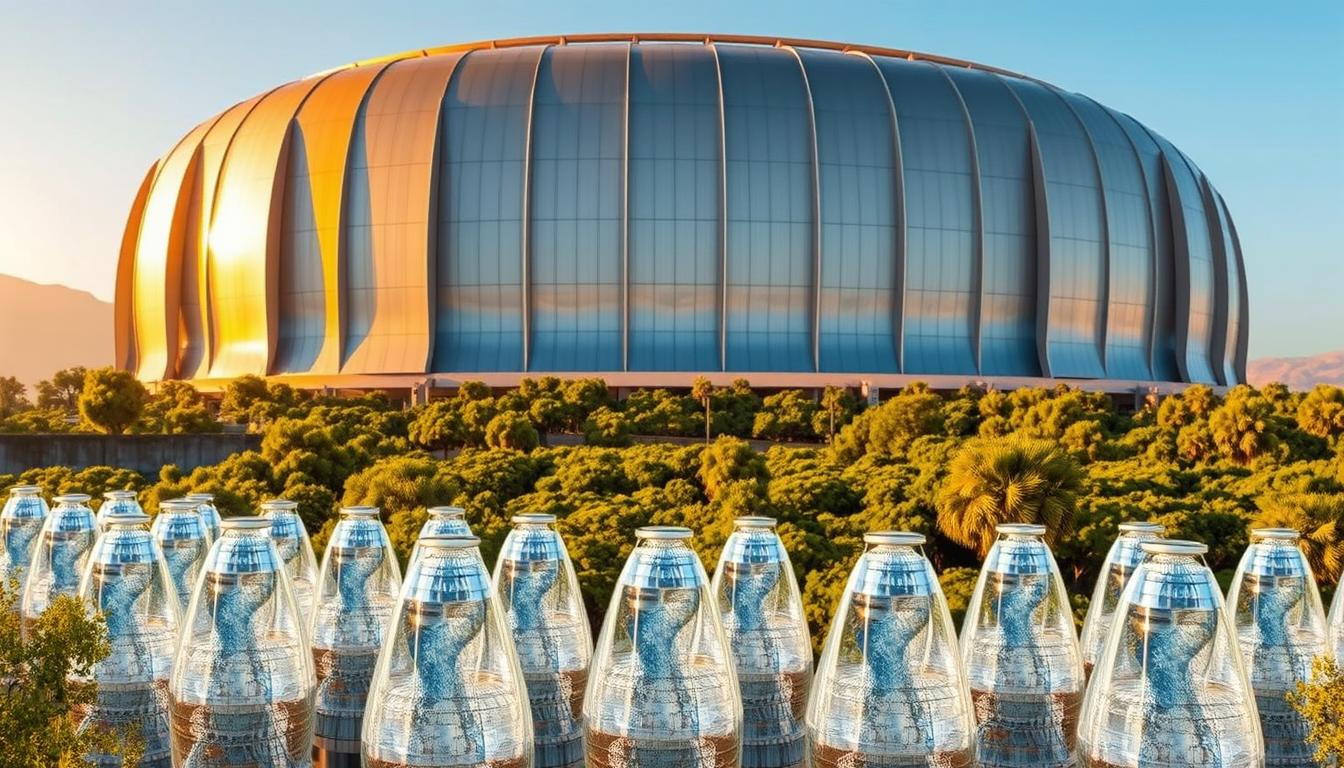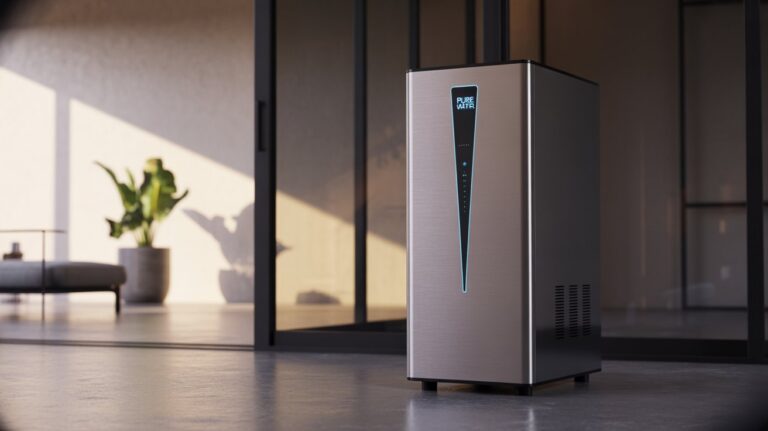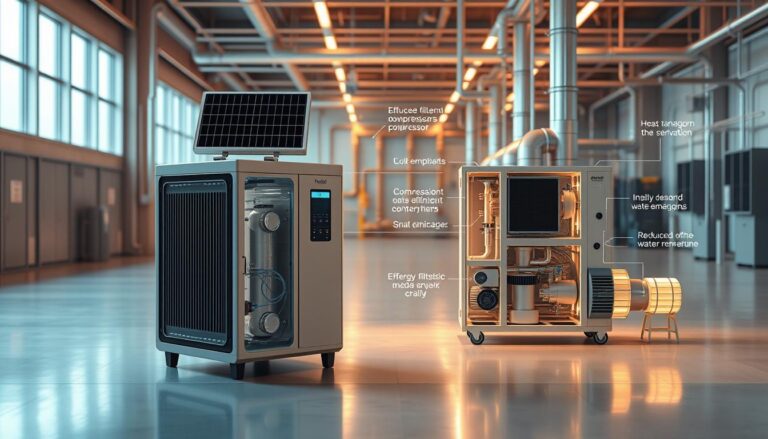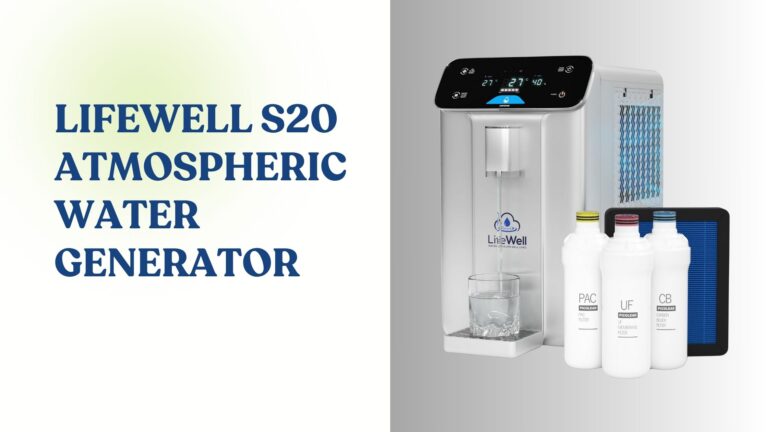Atmospheric Water Generators: Unlock the Power of Renewable Water
Can we really extract clean drinking water from thin air? The answer lies in a revolutionary technology that’s changing the way we think about renewable water sources. Freshwater scarcity is a growing concern worldwide, affecting millions of people. As traditional sources of clean water dwindle, innovative solutions are needed to meet the demand.
Atmospheric water generators offer a sustainable way to harvest clean water directly from the air, reducing reliance on depleted groundwater sources. This technology has the potential to provide a reliable and renewable source of clean water, making it an attractive solution for homeowners, businesses, and industries seeking to reduce their environmental footprint.
Key Takeaways
- Atmospheric water generators provide a sustainable solution to freshwater scarcity.
- This technology harvests clean water directly from the air, reducing reliance on traditional sources.
- Renewable water technology offers a reliable and sustainable source of clean water.
- Ideal for homeowners, businesses, and industries looking to reduce their environmental impact.
- Helps to alleviate the pressure on depleted groundwater sources.
What Are Atmospheric Water Generators?
Atmospheric water generators are innovative devices that produce clean drinking water by harnessing the moisture in the air. These machines offer a clean drinking water solution by extracting, condensing, and purifying water vapor from the atmosphere.
The technology behind atmospheric water generators is based on the principle that air contains water vapor, an untapped resource capable of being converted into clean drinking water. By leveraging this concept, these devices can provide a sustainable source of water, reducing reliance on traditional water sources.
The Science Behind Extracting Water from Air
The process involves condensation or absorption of water vapor into liquid form, followed by filtration to make it safe for consumption. This is achieved through advanced technologies that cool the air or use desiccants to capture moisture.
Evolution of Water Generation Technology
Over the years, atmospheric water generation technology has evolved significantly, with improvements in efficiency, capacity, and energy consumption. For a comprehensive guide on home water independence using atmospheric water generators, visit Aquaria World.
The advancements in this field have made atmospheric water generators more viable as a clean drinking water solution, offering numerous advantages of atmospheric water generators, including reduced plastic bottle waste and independence from municipal water supplies.
How Atmospheric Water Generators Work
The mechanism of atmospheric water generators is rooted in their ability to condense and filter water vapor from the atmosphere. This process involves advanced technologies that can be categorized into several types of systems.
Atmospheric water generators work on the principle of extracting water from the air, which is then treated to make it potable. The main types of systems used are condensation-based, desiccant-based, and hybrid technologies.
Condensation-Based Systems
Condensation-based systems utilize a thermodynamic cycle driven by advanced mechanical refrigeration systems under precise electronic regulation. This process involves cooling the air to its dew point, causing the water vapor to condense into liquid water. Condensation-based systems are highly effective in humid environments, making them suitable for various geographical locations.
Desiccant-Based Systems
Desiccant-based systems, on the other hand, use a desiccant material to absorb moisture from the air. The absorbed water is then extracted through a heating process, resulting in clean water. These systems are particularly useful in dry climates where condensation-based systems might be less effective.
Hybrid Technologies
Hybrid technologies combine the benefits of both condensation-based and desiccant-based systems. By integrating these technologies, hybrid systems can operate efficiently across a wide range of humidity levels, providing a reliable source of clean drinking water in various environmental conditions.
The use of atmospheric water generators represents a significant step towards sustainable water generation and an eco-friendly water source. By understanding how these systems work, we can better appreciate their potential to address global water challenges.
Atmospheric Water Generator Benefits: A Comprehensive Overview
Atmospheric water generators offer a multitude of benefits, revolutionizing the way we access clean drinking water. By extracting water from the air, these innovative systems provide a reliable source of clean water, independent of traditional water sources.
Access to Clean Drinking Water
One of the primary benefits of atmospheric water generators is their ability to provide clean drinking water in various settings. Whether in remote areas, disaster zones, or regions facing severe water scarcity, these systems can extract water from the air, delivering a reliable source of drinking water.
Independence from Traditional Water Sources
Atmospheric water generators offer independence from traditional water sources, such as rivers, lakes, and groundwater. This is particularly beneficial in areas where these sources are unreliable, contaminated, or scarce. By harnessing the power of the air, communities can access clean water without relying on infrastructure that may be lacking or compromised.
Disaster Relief Applications
In disaster relief scenarios, atmospheric water generators can play a critical role in providing clean drinking water to affected populations. Their ability to operate independently of traditional water infrastructure makes them an invaluable resource in emergency response situations.
The benefits of atmospheric water generators are multifaceted, addressing various aspects of water scarcity and access to clean drinking water. As the world continues to face challenges related to water, these innovative systems offer a promising solution, providing a reliable and cost-effective means of producing clean water.
Environmental Advantages of Atmospheric Water Generators
The environmental benefits of atmospheric water generators are multifaceted and significant. By providing a clean and sustainable source of water, these systems address several pressing environmental issues.
Reducing Plastic Bottle Waste
One of the most significant environmental advantages of atmospheric water generators is their ability to reduce plastic bottle waste. The production, transportation, and disposal of plastic bottles have severe environmental consequences.
Statistics on Plastic Pollution
It’s estimated that over 8 million tons of plastic waste enter our oceans every year, harming marine life and ecosystems. “Plastic pollution is one of the most pressing environmental issues of our time.”
Direct Environmental Impact
By using atmospheric water generators, we can directly reduce the demand for bottled water, thereby decreasing plastic waste. This shift can significantly lower the environmental footprint associated with bottled water consumption.
Minimizing Water Transportation Impacts
Atmospheric water generators produce water locally, minimizing the need for transportation. This reduction in transportation not only saves energy but also decreases carbon emissions, contributing to a cleaner environment. As noted by experts,
“Local water production can significantly reduce the carbon footprint associated with water distribution.”
Sustainable Water Generation as an Eco-friendly Water Source
Atmospheric water generators are an eco-friendly water source because they harness a renewable resource—water vapor in the air. For more information on the benefits of atmospheric water generators, visit https://homewatertreatmentsystems.com/exploring-the-benefits-of-atmospheric-water-generators/.
By adopting atmospheric water generators, communities can move towards a more sustainable and environmentally friendly water production method.
Health Benefits of Water from Atmospheric Generators
The water produced by atmospheric generators is not only clean but also meets the highest standards of quality. This is due to the thorough treatment processes applied to both the incoming air and the generated water, ensuring a clean drinking water solution that is safe for consumption.
Purity Compared to Other Water Sources
Atmospheric water generators produce water that is often purer than traditional water sources. The process involves filtering the air to remove contaminants, resulting in water that is free from many pollutants found in surface or groundwater sources.
- Free from bacteria and viruses
- Low in dissolved solids
- No chemical contaminants
Mineral Content and Health Implications
While the water from atmospheric generators is very pure, it may initially lack minerals. However, many systems are designed to reintroduce beneficial minerals, enhancing the water’s taste and nutritional value. This results in a sustainable water generation method that not only provides clean water but also supports overall health.
By providing a reliable source of clean drinking water, atmospheric water generators contribute significantly to public health, especially in areas where water scarcity is a concern.
Cost-Effective Water Production Analysis
As the world shifts towards more sustainable practices, understanding the cost-effectiveness of atmospheric water generators becomes increasingly important. The initial investment in such technology can be substantial, but it’s crucial to consider the long-term savings and benefits.
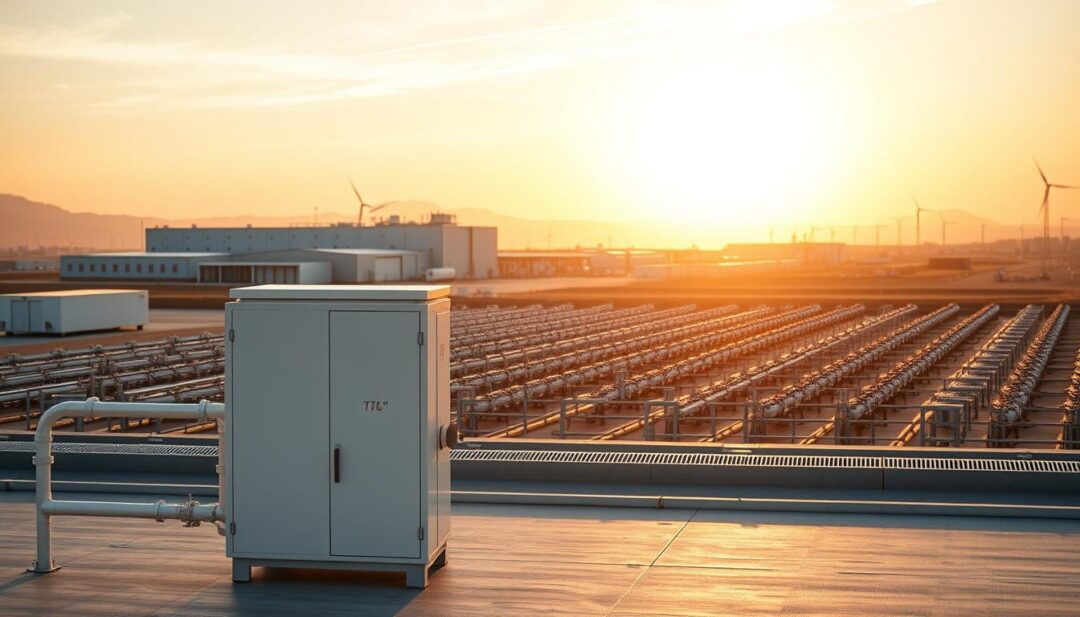
Initial Investment vs. Long-Term Savings
The initial cost of an atmospheric water generator can be significant, but the long-term savings on water bills, transportation, and storage can outweigh this expense. For instance, a study on off-grid water systems highlights the potential for substantial savings over time. By generating water on-site, individuals and organizations can reduce their reliance on municipal water supplies and lower their water costs.
Energy Consumption Considerations
One of the key factors affecting the cost-effectiveness of atmospheric water generators is energy consumption. While these systems require electricity to operate, many modern units are designed with energy efficiency in mind. By minimizing energy consumption, atmospheric water generators can help reduce overall operating costs and make the technology more financially viable.
Maintenance Requirements and Costs
Regular maintenance is essential to ensure the optimal performance of atmospheric water generators. This includes tasks such as filter replacements and system checks. While these maintenance requirements incur additional costs, they are crucial for extending the lifespan of the equipment and ensuring the quality of the generated water.
Types of Atmospheric Water Generators for Different Needs
Atmospheric water generators come in various types to cater to different needs, from residential use to commercial and industrial applications. The diversity in their design and capacity makes them suitable for a wide range of settings, ensuring that clean drinking water is accessible to everyone.
Residential Units
For home use, atmospheric water generators are designed to be compact and efficient. They provide a reliable source of clean drinking water, reducing reliance on bottled water.
Small-Scale Solutions for Homes
These units are perfect for families, with capacities ranging up to 20 liters per day. They are energy-efficient and can be easily integrated into existing home water systems.
Integration with Existing Water Systems
Residential atmospheric water generators can be connected to existing plumbing, providing a seamless experience. This integration ensures that households have a constant supply of clean drinking water.
Commercial and Industrial Systems
For businesses and industries, larger atmospheric water generators are available, capable of producing up to 10,000 liters or more per day. These systems are ideal for offices, hotels, and manufacturing facilities that require a significant amount of clean water.
| Type | Capacity (Liters/Day) | Application |
|---|---|---|
| Residential | Up to 20 | Homes, Small Offices |
| Commercial | 100 – 1,000 | Offices, Hotels, Restaurants |
| Industrial | 1,000 – 10,000+ | Manufacturing Facilities, Large Commercial Establishments |
Portable and Emergency Solutions
Portable atmospheric water generators are designed for emergency situations or outdoor activities. They are compact, lightweight, and can provide clean drinking water in remote or disaster-stricken areas.
“Atmospheric water generators offer a sustainable solution for clean drinking water, reducing our reliance on plastic bottles and traditional water sources.” –
The variety of atmospheric water generators available ensures that there is a suitable solution for every need, whether it’s for daily household use, commercial purposes, or emergency relief.
Implementing Renewable Water Technology in Various Settings
Atmospheric water generators are revolutionizing the way we access clean water in various settings. These innovative devices provide a reliable source of clean drinking water, reducing dependence on traditional water sources and minimizing environmental impact.
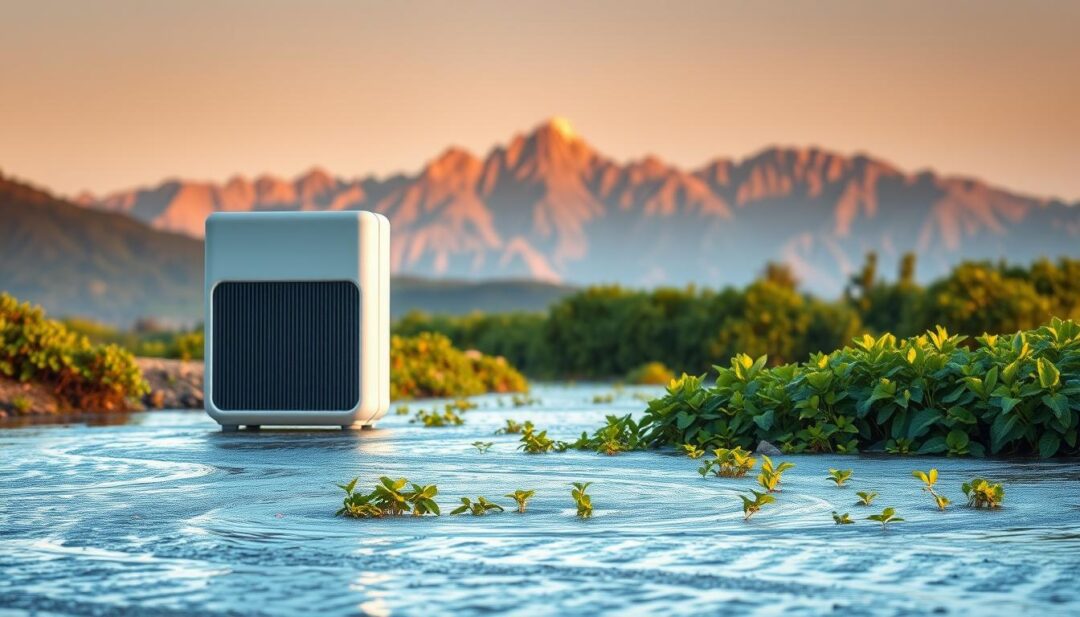
Urban Applications
In urban areas, atmospheric water generators can supplement municipal water supplies, providing an eco-friendly water source for drinking, cooking, and other uses. They can be particularly useful in cities with aging infrastructure or during times of water scarcity.
Rural and Remote Area Solutions
Rural and remote communities often face significant challenges in accessing clean water. Atmospheric water generators offer a sustainable water generation solution, providing a reliable and local source of clean drinking water without the need for extensive infrastructure.
Humanitarian and Crisis Response Uses
In humanitarian and crisis response situations, atmospheric water generators can be a vital resource. As
“Atmospheric water generators can provide a mobile, or even off-grid, reliable water supply and reduce the use of plastic in water bottles.”
They can be deployed quickly to provide clean drinking water to affected populations, reducing the risk of waterborne diseases.
By implementing renewable water technology in various settings, we can ensure a more sustainable and resilient water future. As the world continues to adopt sustainable water generation practices, the potential for atmospheric water generators to make a positive impact is vast.
Overcoming Challenges in Atmospheric Water Generation
While atmospheric water generation technology holds great promise, it faces challenges that must be addressed to optimize its performance. One of the primary concerns is the variability in climate and humidity levels, which significantly impacts the efficiency of atmospheric water generators.
Climate and Humidity Considerations
Water production rates are largely controlled by air temperature and humidity. Ideal operating temperatures range from 21-32 ºC with relative humidity between 40 percent and 100 percent. Understanding these conditions is crucial for selecting the right atmospheric water generator for specific locations.
Energy Efficiency Improvements
Energy consumption is another significant challenge. To improve energy efficiency, manufacturers are developing more advanced systems that can optimize energy use based on the operating conditions. Advancements in technology have led to more cost-effective water production methods.
Maintenance and Filtration Requirements
Regular maintenance and proper filtration are essential to ensure the quality of the water produced. This includes replacing filters and checking for any system malfunctions. A well-maintained system not only provides cleaner water but also operates more efficiently.
| Challenge | Solution | Benefit |
|---|---|---|
| Climate and Humidity Variability | Understanding Ideal Operating Conditions | Optimized Water Production |
| Energy Consumption | Advanced Energy-Efficient Systems | Cost-Effective Water Production |
| Maintenance and Filtration | Regular Maintenance and Filter Replacement | Cleaner Water and Efficient Operation |
Conclusion: Embracing the Potential of Atmospheric Water Generation
Atmospheric water generators offer a sustainable and reliable source of potable water, especially in regions where traditional water resources are scarce or unreliable. By harnessing the power of renewable water technology, these systems provide a viable solution to global water needs.
The benefits of atmospheric water generators are multifaceted, ranging from access to clean drinking water to reduced plastic bottle waste. As the world continues to grapple with water scarcity and environmental challenges, the importance of atmospheric water generator benefits cannot be overstated.
Implementing renewable water technology can have a significant impact on communities worldwide. By adopting this innovative solution, individuals and organizations can contribute to a more sustainable future, ensuring that clean water is available for generations to come.

